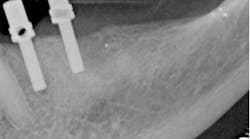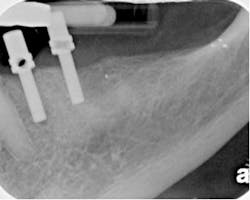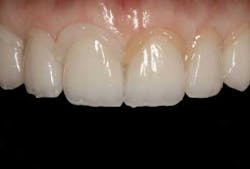Strategic synergies: the relationship between straight line access and apical third shaping
Oct. 19, 2009
By Richard E. Mounce, DDS
Adequate access is a vital first step in attaining tactile control over all aspects of cleaning and shaping, especially in the apical third. Alternatively, deficient access is the harbinger to iatrogenic events, undetected caries, fractures, leaking restorations, etc. — all of which can predispose the procedure to clinical failure.
Ideal access requires that:
- All caries, overhanging restorations, and unsupported tooth structure should be removed.
- All canals should be visible in one mirror view.
- Crowns should be removed before endodontic treatment. This said, there are certainly cases where access through a crown is the most practical course of action.
- The cervical dentinal triangle should be removed.
Cases instrumented with the Twisted File* and RealSeal* bonded obturation.ArmamentariumExcellent straight-line access is far simpler if accomplished through the surgical operating microscope (SOM) (Global Surgical, St. Louis, Mo.). Every aspect of the process is more predictable with the magnification and visualization of the SOM. Its value in all aspects of endodontic treatment as well as access and orifice management cannot be overstated. Access bur kits can be helpful. Some kits, such as the LA Axxess kit, are universal in that they have all the needed burs for even the most challenging clinical cases. The LA Axxess kit includes a round diamond porcelain access bur, a transmetal bur for metal, three round burs (2, 4, and 6 sizes), a course diamond football-shaped bur for gross tooth structure removal, and two diamonds for fine axial preparation. The kit also contains a safe ended diamond for refinement of access walls and stainless steel line angle burs that can be used as orifice shapers as well as to create straight-line access.
The LA Axxess kit*
The LA Axxess kit 2.0*Used in a slow-speed handpiece, these line angle burs (of three varying tip sizes) are safe ended at the tip and do not cut on their ends. Line angle burs are used with the same precautions as Gates Glidden drills. As the line angle bur is inserted, it should be allowed to enter the coronal third passively. It is never forced. The line angle burs can be used in a brushing motion up and away from the furcation so as to remove the cervical dentinal triangle and remove restrictive dentin over the orifice. Using the line angle burs passively with a brushing motion will minimize the chances of perforation and/or excessive removal of coronal third tooth structure. Risk of perforation is greatest at the distal aspect of the mesial root of a lower molar and the distal aspect of the mesial buccal root of the upper first molar. The LA Axxess kit is available in a modified 2.0 version without the aforementioned prepping diamonds and line angle burs, and yet contains a safe ended diamond for high-speed alignment of access walls. Access is made in the context of the given tooth being entered. The clinician should be aware of the diagnosis of the tooth being started. If the tooth is vital, clinicians should anticipate that they will see hemorrhage. If the tooth is necrotic, they should expect either a dry chamber or non-vital pulp tissue. While this might seem obvious, neglecting to appreciate that the pulp chamber has been reached can lead to excessive removal of dentin along its floor or leave the pulp chamber unroofed. In addition to being cognizant of the pulpal diagnosis, especially in non-vital teeth that are covered by crowns, correctly managing a calcified orifice, once uncovered, is essential. Clinically, this means that in the most challenging cases, #6, #8, and #10 pre-curved hand K files are used to assure that the canal is open, patent, and negotiable to the apex before bringing orifice openers of any type into the canal. Using orifice openers too fast and forcefully into a calcified canal can easily lead to blockage and other iatrogenic issues. Reciprocating a #6 hand K file with the M4 Safety Handpiece* can easily and efficiently prepare the canal diameter of a #8 hand K file, a #8 hand K file to the canal diameter of a #10, etc.
The M4 Safety Handpiece*The M4 mimics the watch-winding motion of hand K file enlargement by reciprocating a hand K file 30 degrees clockwise and 30 degrees counterclockwise. The M4 is used in an E-type coupling in an electric motor at the 18:1 setting at 900 rpm. The (#6, #8, #10) hand K file that binds at the TWL or the estimated working length is first fed into the canal by hand to this level. The M4 is then placed onto the hand K file and with a 1 mm to 3 mm vertical amplitude of motion, the hand K file is reciprocated for 15 to 30 seconds. After the file begins to reciprocate freely (after the 15 to 30 seconds), the canal is irrigated and recapitulated, and the next larger hand K file is placed to length and reciprocated until the canal is enlarged to a #15 hand K file size equivalent. At this stage, a glide path has been created and rotary nickel titanium file enlargement commences. Straight-line access and its importance in all phases of endodontic cleanings and shaping have been addressed. Emphasis has been placed on making endodontic access large enough that the files inserted into the canal can be placed into the straightaway portions of the root without displacement off of the canal walls. The LA Axxess kit has been discussed as well as the capability of the Twisted File to shape the canal orifice after canal location. I welcome your feedback. *SybronEndo, Orange, Calif.
Richard E. Mounce, DDS, lectures globally and is widely published. He is in private practice in endodontics in Vancouver, Wash. Contact him at [email protected].











